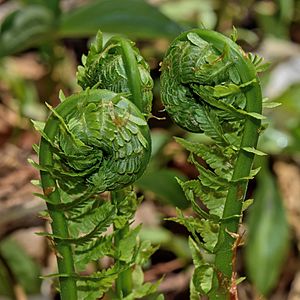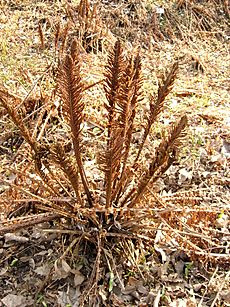Matteuccia facts for kids
Quick facts for kids Matteuccia |
|
|---|---|
 |
|
| Ostrich fern in Rouge National Urban Park (Ontario, Canada). | |
| Scientific classification | |
| Genus: |
Matteuccia
|
| Species: |
struthiopteris
|
| Synonyms | |
|
List of synonyms
Matteuccia pensylvanica (Willd.) Raymond
Matteuccia pennsylvanica (Willd.) Raymond (common misspelling) Onoclea struthiopteris L. Pteretis nodulosa Matteuccia nodulosa Fernald Matteuccia struthiopteris subsp. pensylvanica (Willd.) Á. Löve & D. Löve Onoclea pensylvanica (Willd.) Sm. Pteretis pensylvanica (Willd.) Fernald Pteretis struthiopteris var. pensylvanica (Willd.) Farw. Struthiopteris nodulosa Desv. Struthiopteris pensylvanica Willd. Struthiopteris filicastrum All. Pteris sinuata Thunb. |
|
Matteuccia is a genus of ferns with one species: Matteuccia struthiopteris (common names ostrich fern, fiddlehead fern, or shuttlecock fern). The species epithet struthiopteris comes from Ancient Greek words στρουθίων (strouthíōn) "ostrich" and πτερίς (pterís) "fern".
Description
The fronds are dimorphic, with the deciduous green sterile fronds being almost vertical, 100–170 cm (39–67 in) tall and 20–35 cm (7.9–13.8 in) broad, long-tapering to the base but short-tapering to the tip, so that they resemble ostrich plumes, hence the name. The fertile fronds are shorter, 40–65 cm (16–26 in) long, brown when ripe, with highly modified and constricted leaf tissue curled over the sporangia; they develop in autumn, persist erect over the winter and release the spores in early spring. Along with Dryopteris goldieana, it is one of the largest species of fern in eastern North America.
Classification
Matteuccia struthiopteris is the only species in the genus Matteuccia. Some sources include two Asian species, M. orientalis and M. intermedia, but molecular data shows that M. struthiopteris is more closely related to Onocleopsis and Onoclea (sensitive fern) than it is to M. orientalis and M. intermedia, and so the latter should be moved to a genus Pentarhizidium which contains those two species. Formerly classified as a member of the Dryopteridaceae, Matteuccia has been reassigned to the new much smaller family Onocleaceae.
Distribution
It is a crown-forming, colony-forming plant, occurring in temperate regions of the Northern Hemisphere in central and northern Europe, northern Asia, and northern North America. It grows from a completely vertical crown, favoring riverbanks and sandbars, but sends out lateral stolons to form new crowns. It can thus form dense colonies resistant to destruction by floodwaters.
Cultivation and uses

The ostrich fern is a popular ornamental plant in gardens. It has gained the Royal Horticultural Society's Award of Garden Merit. While choosing a place of planting it should be taken into account that this fern is very expansive and its leaves often lose their beauty throughout the summer, especially if not protected from wind and hail.
The tightly wound immature fronds, called fiddleheads, are also used as a cooked vegetable, and are considered a delicacy mainly in rural areas of northeastern North America. It is considered inadvisable to eat uncooked fiddleheads. Brown "scales" are inedible and should be scraped or rinsed off.
The sprouts are also picked all over Japan, ("kogomi" in Japanese) where they are a delicacy.
Matteuccia species are used as food plants by the larvae of some Lepidoptera species including Sthenopis pretiosus.
See also
 In Spanish: Matteuccia struthiopteris para niños
In Spanish: Matteuccia struthiopteris para niños


